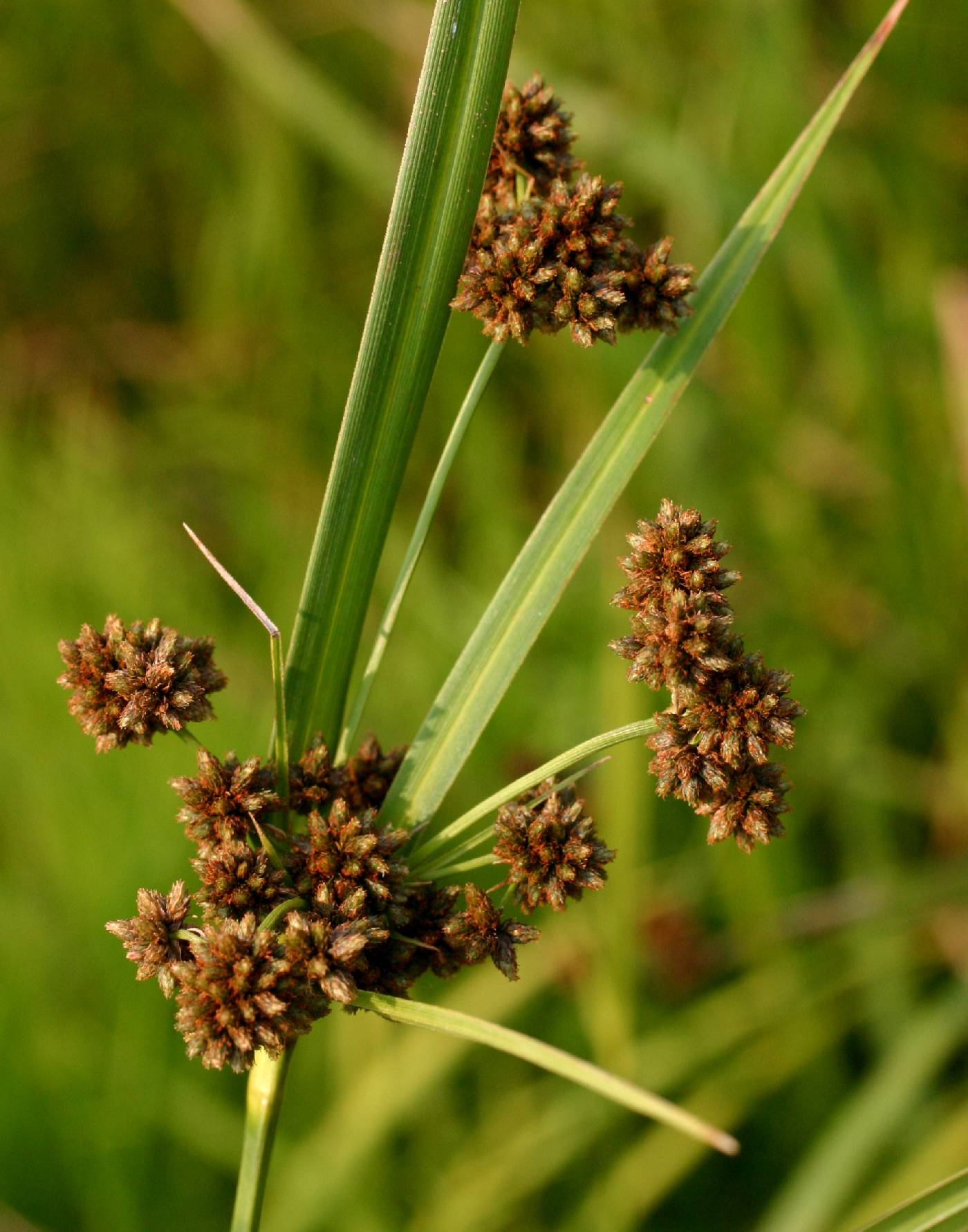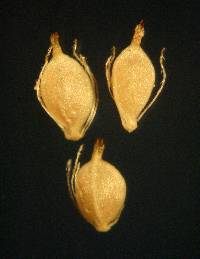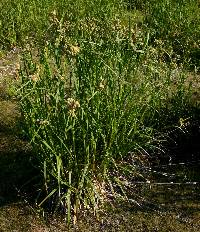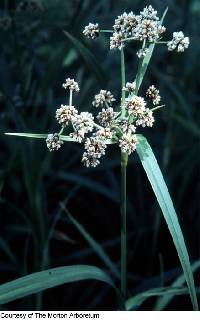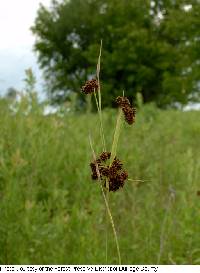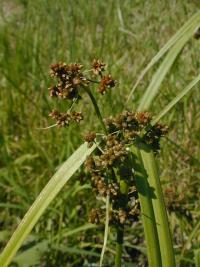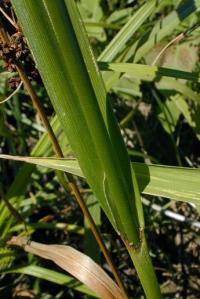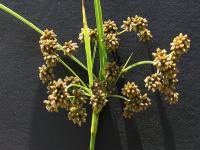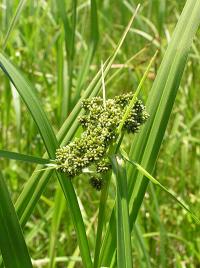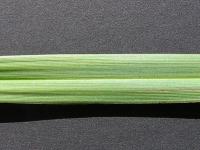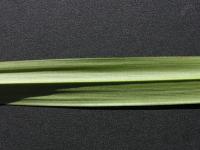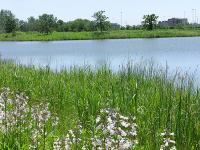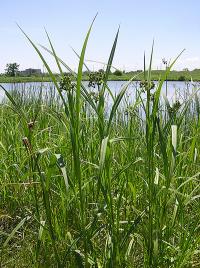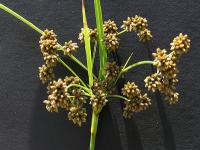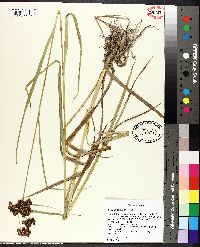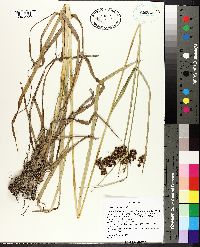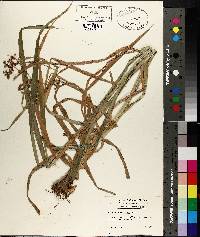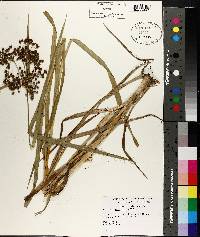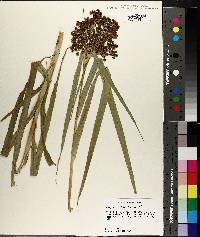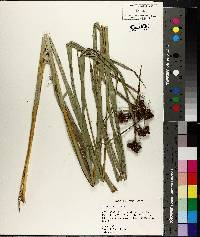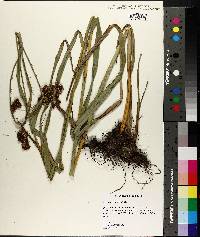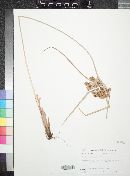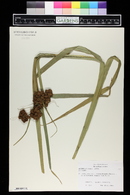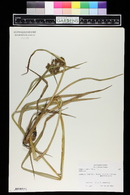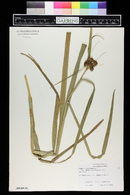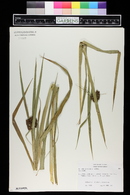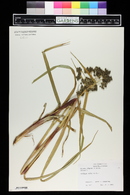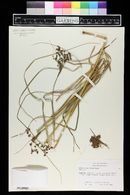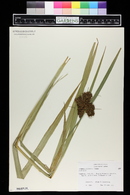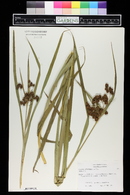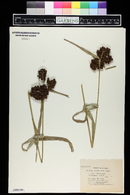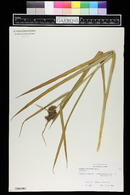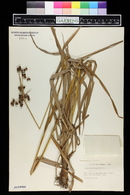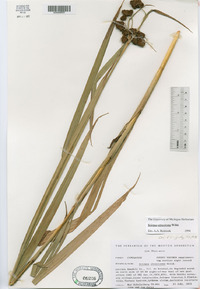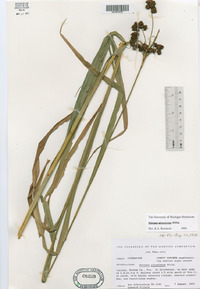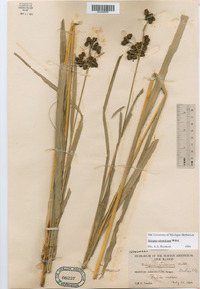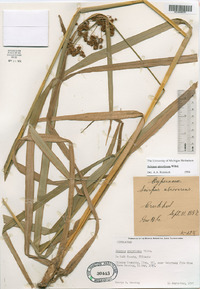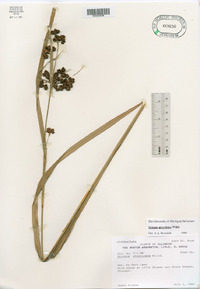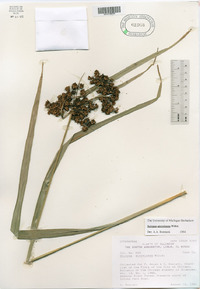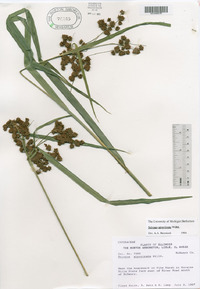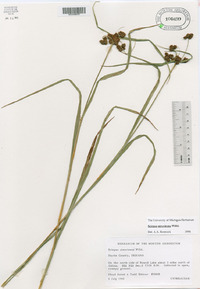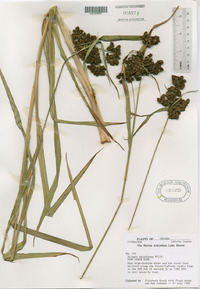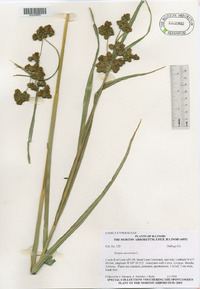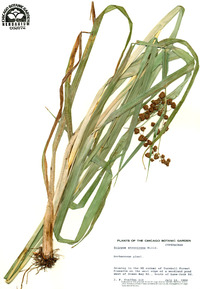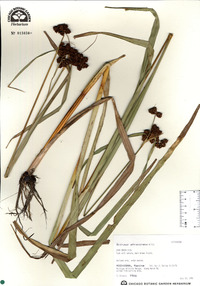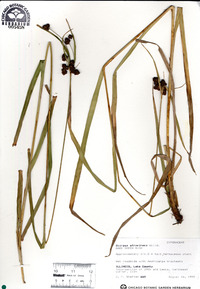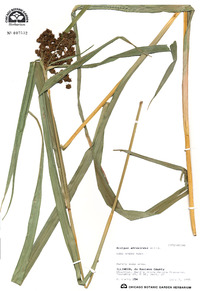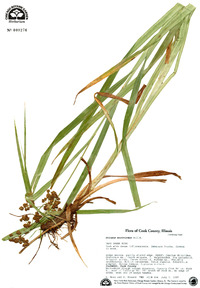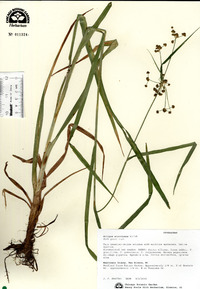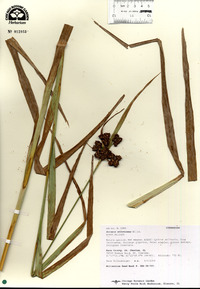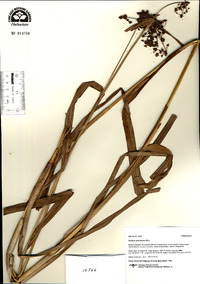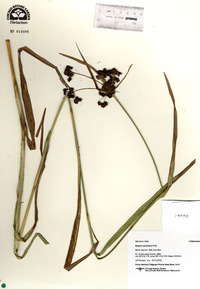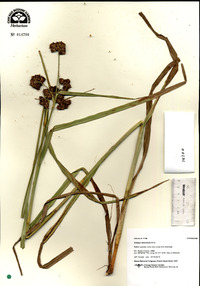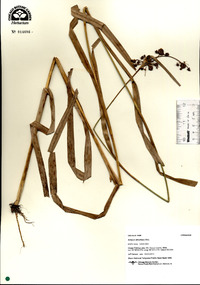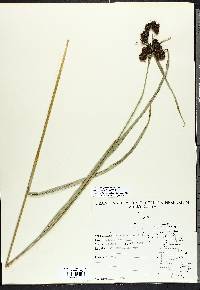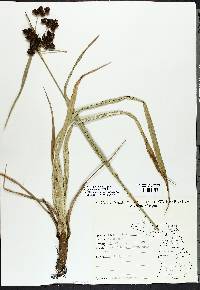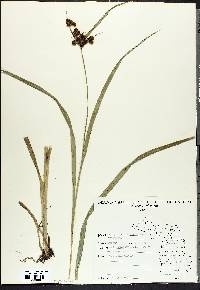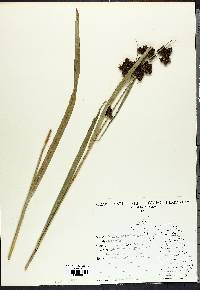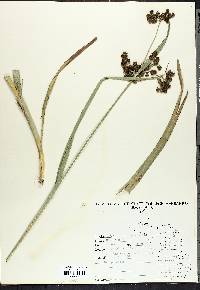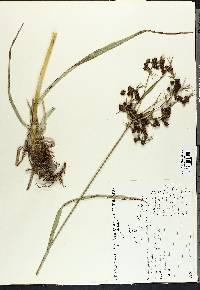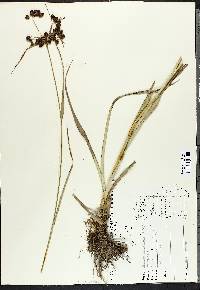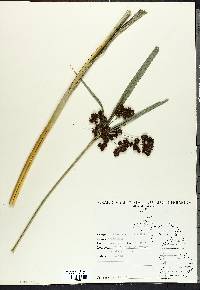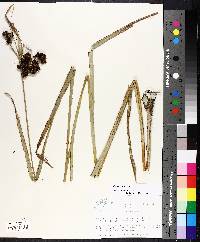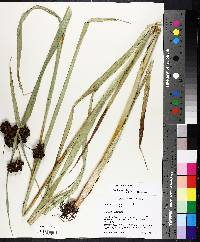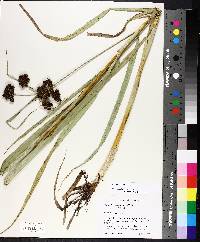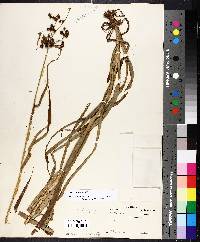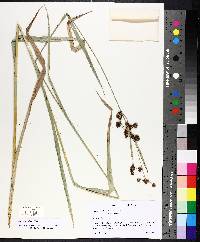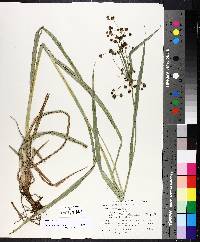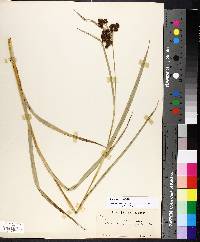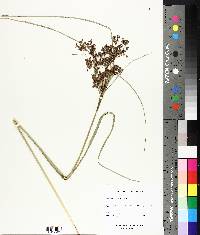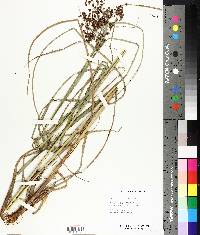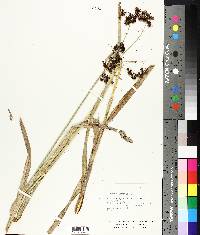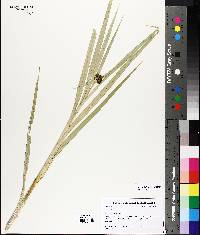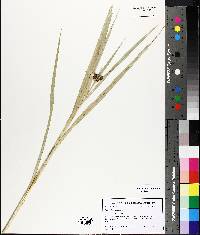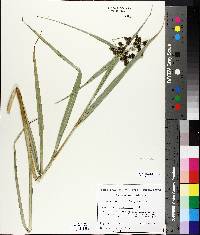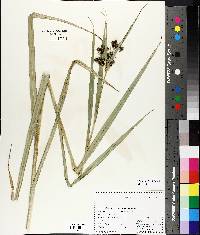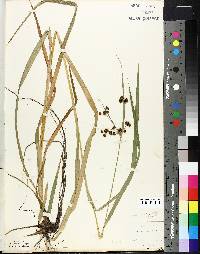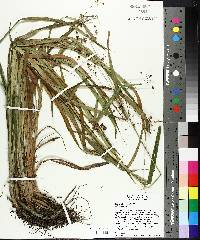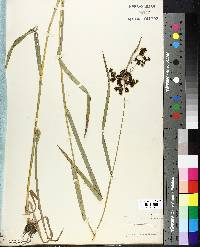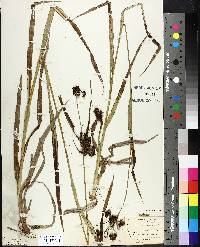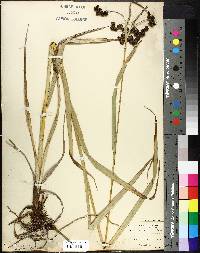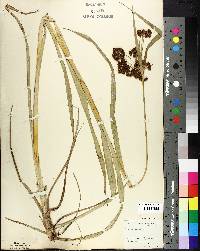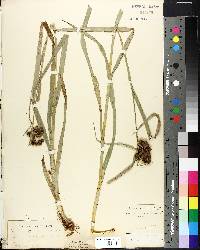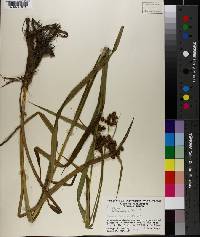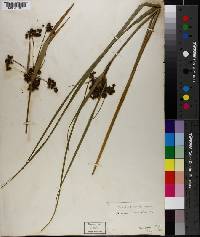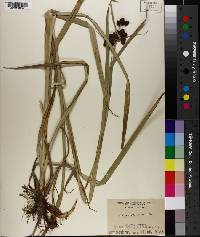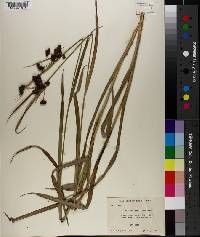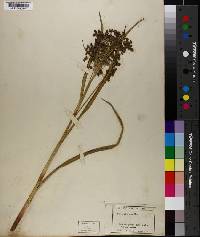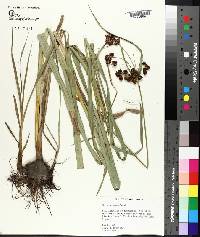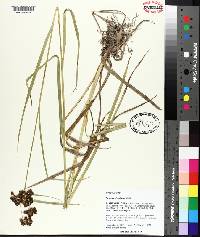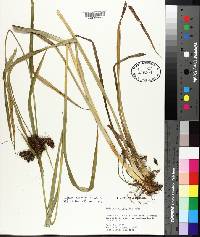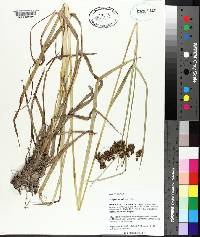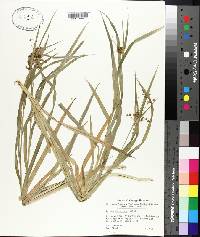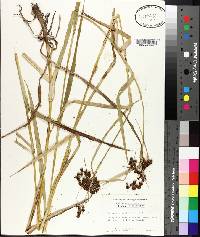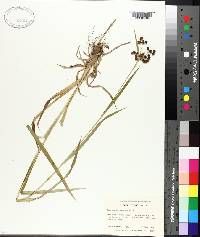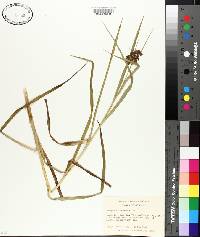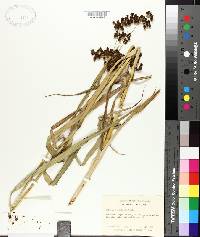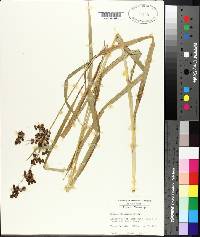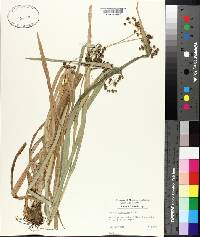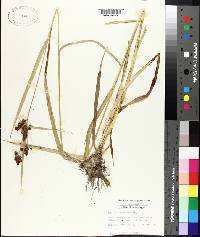Scirpus atrovirens
|
|
|
|
Family: Cyperaceae
Dark-Green Bulrush, more...green bulrush
[Scirpus atrovirens f. angustispicatus Fernald, moreScirpus atrovirens f. cephalanthus Fernald, Scirpus atrovirens f. proliferus F.J.Herm., Scirpus atrovirens f. sychnocephalus (S.N.Cowles) S.F.Blake, Scirpus atrovirens var. pycnocephalus Fernald] |
Plants cespitose; rhizomes short, tough, fibrous. Culms: fertile ones upright or nearly so; nodes without axillary bulblets. Leaves 6-11 per culm; sheaths of proximal leaves light brown; proximal sheaths and blades with septa many, ± conspicuous; blades 20-54 cm × 7-17 mm. Inflorescences terminal, rarely also with 1 lateral inflorescence from distal leaf axil; rays ascending or divergent (commonly both in the same inflorescence), proximal branches smooth, distal branches scabrellous to scabrous, rays often bearing axillary bulblets; bases of involucral bracts green, margins usually speckled with red-brown, rarely solid black, not glutinous. Spikelets in dense clusters of 4-110 (largest cluster with 17-25+), spikelets sessile, ovoid to narrowly ovoid, 2-5(-8) × 1-2.5 mm; scales dark brown with pale midribs, elliptic or broadly elliptic (rarely almost circular), 1.2-2.1 mm, apex mucronate, mucro 0.1-0.3(-0.4) mm. Flowers: perianth bristles persistent, (5-)6, rather stout to somewhat slender, straight or curved, shorter than to slightly exceeding achene, with retrorse, thin-walled, round-tipped barbs in distal 0.3-0.6, enclosed within scales; styles 3-fid. Achenes light brown, elliptic or obovate in outline, plumply trigonous or plano-convex, (0.8-)1-1.3 × 0.4-0.6 mm. 2n = 50-60. Fruiting late spring-early summer (late Jun-Jul). Marshes, moist meadows; 0-900 m; Man., Nfld. and Labr. (Nfld.), Ont., Que.; Ala., Ariz., Conn., Del., D.C., Ga., Ill., Ind., Iowa, Kans., Ky., La., Maine, Md., Mass., Mich., Minn., Mo., Mont., Nebr., N.H., N.J., N.Y., N.Dak., Ohio, Okla., Pa., R.I., S.Dak., Tenn., Tex., Vt., Va., W.Va., Wis. Scirpus atrovirens is variable and often confused with all of its close relatives: S. georgianus, S. flaccidifolius, S. hattorianus, and S. pallidus. The septa in the blades and sheaths of the proximal leaves tend to be more prominent in S. atrovirens than in any of the related species, so that the leaves and sheaths appear distinctly nodulose in dried specimens. The scales have relatively little black pigmentation, so that the heads appear brownish, not blackish as in S. pallidus, S. hattorianus, and S. flaccidifolius. Scirpus atrovirens occasionally hybridizes with S. georgianus, S. hattorianus, S. pallidus, and S. polyphyllus.
Perennial herb with short, tough rhizomes, tufted to 1.5 m tall Leaves: three-ranked, six to eleven per culm. Sheaths of lower leaves light brown. Blades 20 cm - 0.5 m long, 7 - 18 mm wide, keeled beneath. Inflorescence: a large, open or compact arrangement of spikelets, terminal, head-like, one- or two-times branched with ascending or diverging stalks (which often bear axillary bulblets), subtended by three leaf-like bracts. Bracts green basally and reddish brown along the margins. Flowers: minute, subtended by a floral scale, lacking sepals and petals, bearing six persistent bristles. Bristles slender to stout, curved or straight, shorter than to slightly longer than achene, bearing small barbs on the top two-thirds, enclosed inside the scales. Stamens one to three, exserted. Pistil one. Style linear, three-cleft, base persistent. Fruit: a one-seeded achene, light brown, about 1 mm long and 0.5 mm wide, elliptic or reverse egg-shaped, three-sided and plump or flat on one side and convex on the other, minutely bumpy. Culm: to 1.5 m long, three-sided, solid. Spikelets: in dense clusters of 4 to 110, stalkless, 2 - 8 mm long, 1 - 2.5 mm wide, narrowly egg-shaped to egg-shaped. Floral scales spirally arranged, dark brown with a pale midrib, 1 - 2 mm long, elliptic to widely elliptic with a rounded apex that bears a tiny point. Similar species: No information at this time. Flowering: June to early August Habitat and ecology: Common in marshy ground, often near ditches, streams, or ponds. Also found in mucky and springy ground. Occurence in the Chicago region: native Etymology: Scirpus comes from the Latin name for a bulrush. Atrovirens means "very green." Author: The Morton Arboretum Cespitose perennial to 1.5 m from short tough rhizomes; main lvs to 18 mm wide, mostly on the lower half of the stem, the lower sheaths and blades usually septate-nodulose; infl open or sometimes very compact, once or usually twice widely branched, often with axillary bulblets; spikelets ovoid or short-cylindric, 2-8 mm, all densely crowded in subglobose heads; scales 1.4-2.1 mm, broadly elliptic or obovate, brownish or blackish, the pale midvein prolonged into a mucro less than 0.4 mm; bristles mostly 6, shorter to slightly longer than the achene, ±straight, the upper 2/3 retrorsely barbellate; style trifid; achene very pale to white, compressed-trigonous, 0.8-1.2 mm; 2n=50, 52, 54, 56. Swamps and wet meadows; Nf. and Que. to Wash., s. to Ga., Tex., and Ariz. Fr June, July. Most of our plants belong to the highly variable var. atrovirens, as described above. (S. ancistrochaetus, with the bristles barbellate nearly to the base; S. flaccidifolius, local in se. Va. and adj. N.C., with lax stems, the infls lopping over toward the ground; S. georgianus, with 0-3 short bristles; S. hattorianus, with lower blades and sheaths nearly smooth) Westward, mainly w. of Mississippi R., var. atrovirens passes into var. pallidus Britton, with fewer and larger glomerules and more consistently blackish scales 1.8-2.8 mm, the midrib excurrent into an awn-point 0.4-0.7 mm. (S. pallidus) Gleason, Henry A. & Cronquist, Arthur J. 1991. Manual of vascular plants of northeastern United States and adjacent Canada. lxxv + 910 pp. ©The New York Botanical Garden. All rights reserved. Used by permission. From Flora of Indiana (1940) by Charles C. Deam Frequent to common in almost all parts of the state. It is usually found in wet, mucky soil in ditches and ponds, along streams, and about lakes. One can infrequently find a specimen in which the rays of the inflorescence are short and the glomerules form a closed head. This form has received a name but I do not believe it is of taxonomic significance. …… Indiana Coefficient of Conservatism: C = 4 Wetland Indicator Status: OBL |
|
|
|

